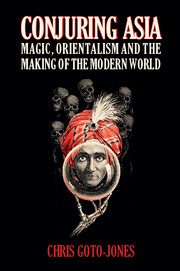1 - Modern magic in history and theory
from Part I
Published online by Cambridge University Press: 05 July 2016
Summary
Modern magic in history (and magic in modern history)
This book is largely concerned with the so-called Golden Age of Magic, which is a grand expression often used to describe the period around the turn of the twentieth century. Useful signposts for this period might be the ‘father of modern magic’, Jean Eugene Robert-Houdin (1805–1871), who was (arguably) the first ‘top hat and tails’ magician of the modern period, and at the other end we have Houdini (Erik Weisz, 1874–1926), who named himself in tribute to Robert-Houdin but then systematically attempted to refute his place in history. The precise historical parameters of this period are not extremely important. It is generally accepted that the early years of the nineteenth century were a low ebb for conjuring and magic, ‘when conjuring proper was so eclipsed by … ghost shows and mechanical contrivances’, but then it was revived by the great innovators of ‘modern magic’. For many, the Golden Age continued at least into the 1930s and the outbreak of World War II. This chapter makes no attempt at a comprehensive history of this period, but rather seeks to sketch its basic shape and contours.
What is important is that this era included many of the great names of stage magic. In addition to Houdini, these included (but were certainly not limited to) Johann Hofzinser (1806–1875), John Henry Anderson (The Great Wizard of the North, 1814–1874), William Palmer (Robert (or Joseph) Heller, 1826–1878), John Nevil Maskelyne (1839–1914), Ira Erastus Davenport & William Henry Davenport (The Davenport Brothers, 1839–1911 & 1841–1877), Harry Kellar (1849–1922), Shōkyokusai Ten'ichi (1852–1912), Zhu Liankui (Ching Ling Foo, 1854–1922), William Robinson (Chung Ling Soo, 1861–1918), Nevil Maskelyne (1863–1924), David Devant (1868–1941), Howard Thurston (1869–1936), Sigmund Neuberger (The Great Lafayette, 1871–1911), Horace Goldin (1873–1939), Harry Jansen (Dante, 1883–1955), Theodore Bamberg (Okito, 1875–1963), Harry Blackstone Sr. (1885–1965).
These men (for they were nearly all men) ushered in the age of modern magic, building custom-made props and mechanical devices, appearing in the great theatres of the Western world, and travelling the world on steam ships in search of new audiences, new markets, new ideas, and fresh inspiration. This was magic on the grand scale – the genuine forebear of Las Vegas spectaculars and global TV specials.
Information
- Type
- Chapter
- Information
- Conjuring AsiaMagic, Orientalism and the Making of the Modern World, pp. 13 - 54Publisher: Cambridge University PressPrint publication year: 2016
